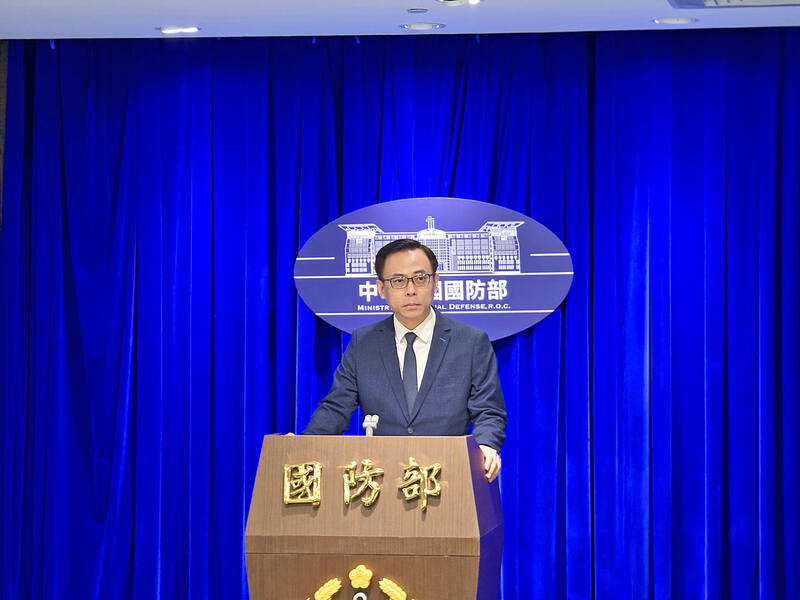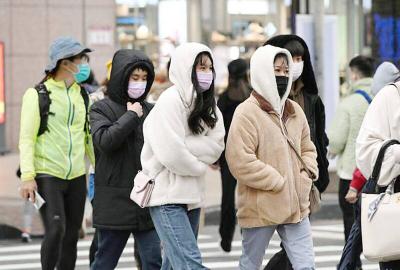The Ministry of National Defense’s Defense Innovation Office (DIO) is working on the logistics to integrate artificial intelligence (AI) with military tasks as well as acquire drones and counter-uncrewed aircraft systems (C-UAS), with a range of small procurement projects slated for next year, a defense official said on Thursday.
The defense ministry unveiled the 2025 National Defense Report earlier the same day, which included a section on the DIO, launched last year, to help source private-sector technologies for military uses.
In response to media queries on whether the office’s responsibilities include integrating AI and drones into the military, Shih Chi-liang (史奇良), an official from the ministry’s Department of Integrated Assessment, said the DIO has established diversified procurement channels for drone and C-UAS systems and is assessing the needs of military units and the General Staff Headquarters before procurement programs are officially initiated.

Photo: Fang Wei-li, Taipei Times
Regarding AI applications, Shih said the office is conducting open solicitations to develop prototypes for three projects: an AI automatic-identification system for satellite imagery, an augmented-reality intelligent combat system and an intelligent warehouse management system.
The selection process for contractors has been finalized and the development of prototypes is expected to begin next year, he said.
Low-quantity purchases are planned for next year to procure items such as fiber-optic equipment, uncrewed aerial systems, light weapons, C-UAS systems and fire-control systems, he added.
“The goal is to deliver these items to units for field trials and evaluation, so we can assess their operational effectiveness and use the results as a reference when considering larger follow-on procurements,” Shih said.
Reporters at the conference asked why the military appears to be under-equipped in counter-drone capabilities, as the report noted that current measures include flare guns, rifles and machine guns.
These solutions have been adopted because drone-jamming systems “have yet to be procured,” the report said.
Director-General of the Administration Office Major General Sun Li-fang (孫立方) said C-UAS systems are evolving rapidly, and the ministry is working diligently to identify which new technologies and systems best meet the nation’s needs.

ALIGNED THINKING: Taiwan and Japan have a mutual interest in trade, culture and engineering, and can work together for stability, Cho Jung-tai said Taiwan and Japan are two like-minded countries willing to work together to form a “safety barrier” in the Indo-Pacific region, Premier Cho Jung-tai (卓榮泰) yesterday said at the opening ceremony of the 35th Taiwan-Japan Modern Engineering and Technology Symposium in Taipei. Taiwan and Japan are close geographically and closer emotionally, he added. Citing the overflowing of a barrier lake in the Mataian River (馬太鞍溪) in September, Cho said the submersible water level sensors given by Japan during the disaster helped Taiwan monitor the lake’s water levels more accurately. Japan also provided a lot of vaccines early in the outbreak of the COVID-19 pandemic,

Kaohsiung Mayor Chen Chi-mai (陳其邁) on Monday announced light shows and themed traffic lights to welcome fans of South Korean pop group Twice to the port city. The group is to play Kaohsiung on Saturday as part of its “This Is For” world tour. It would be the group’s first performance in Taiwan since its debut 10 years ago. The all-female group consists of five South Koreans, three Japanese and Tainan’s Chou Tzu-yu (周子瑜), the first Taiwan-born and raised member of a South Korean girl group. To promote the group’s arrival, the city has been holding a series of events, including a pop-up

TEMPORAL/SPIRITUAL: Beijing’s claim that the next Buddhist leader must come from China is a heavy-handed political maneuver that will fall flat-faced, experts said China’s requirement that the Dalai Lama’s reincarnation to be born in China and approved by Beijing has drawn criticism, with experts at a forum in Taipei yesterday saying that if Beijing were to put forth its own Dalai Lama, the person would not be recognized by the Tibetan Buddhist community. The experts made a remarks at the two-day forum hosted by the Tibet Religious Foundation of His Holiness the Dalai Lama titled: “The Snow Land Forum: Finding Common Ground on Tibet.” China says it has the right to determine the Dalai Lama’s reincarnation, as it claims sovereignty over Tibet since ancient times,

Temperatures in some parts of Taiwan are expected to fall sharply to lows of 15°C later this week as seasonal northeasterly winds strengthen, the Central Weather Administration (CWA) said today. It is to be the strongest cold wave to affect northern Taiwan this autumn, while Chiayi County in the southwest and some parts of central Taiwan are likely to also see lower temperatures due to radiational cooling, which occurs under conditions of clear skies, light winds and dry weather, the CWA said. Across Taiwan, temperatures are to fall gradually this week, dropping to 15°C to 16°C in the early hours of Wednesday